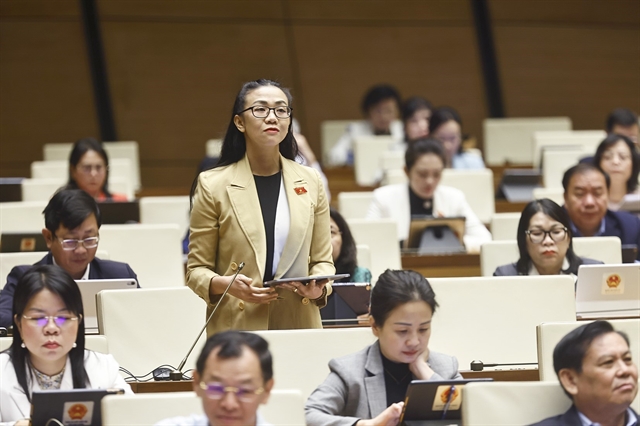 Society
Society

 |
| Many policy have been introduced to encourage women to give birth. — Photo vov.vn |
HÀ NỘI — Việt Nam is facing mounting demographic pressure as its fertility rate has now fallen well below replacement level, gender imbalances at birth persist and the quality of its population falls short of development needs while the process of ageing accelerates.
To counter these trends, many localities are offering incentives to women who have two children before age 35, in an effort to maintain the replacement birth rate.
Yet experts say that without broader support for child-rearing and long-term security, these measures will deliver only short-term relief.
Dr Nguyễn Minh Phong of the Hà Nội Socio-Economic Development Institute warns that the shortage of people of reproductive age is not unique to Việt Nam but is increasingly common among many countries, including those which are already highly developed.
In this context, the State is taking steps such as abolishing regulations around having a third child, which will favour couples who wish to expand their families. Besides this reform, the government should focus on policies to reduce the cost of raising a child – one of the major hurdles for young couples – since both financial burden and limited time deter many from having children.
“Direct financial support measures play a key role in encouraging child-bearing, helping to reduce anxiety and pressure for young families,” Phong said. “However incentives alone will not be enough to change child-bearing behaviour sustainably. Policies need to be implemented synchronously, combining financial support, improving parental leave conditions, ensuring suitable housing and reducing the cost of educating and raising young children.”
Beyond economics, Phong emphasised that “social and psychological barriers are also reasons why young people hesitate to have children. A portion of young people, particularly Generation Z, are pursuing individualistic lifestyles prioritising self-enjoyment and viewing having children as a burden, even as something outdated. This is a distorted perception that needs to be corrected through communication and education and the promotion of family values, social responsibility, as well as the importance of maintaining the replacement fertility rate for the nation’s sustainable development.”
If the birth rate remains low, Phong said, then in 10 or 20 years, Việt Nam could face a risk of population decline – a path already being travelled by countries such as Japan. In a world of natural disasters, epidemics and global economic fluctuations, maintaining replacement fertility is of vital importance. To that end, Việt Nam must build a coherent institutional system combining socio-economic policies and orientated communication so as to keep the birth rate at an appropriate level – an important foundation for future stable, sustainable and strong development.
Policy is attractive but only short-term effect
Dr Hoàng Tú Anh, director of the Centre for Creative Initiatives in Health and Population (CCIHP), noted that while the policy of “cash rewards for childbirth” may appear easy to implement and appealing at first glance, both domestic and international experience show that isolated financial incentives tend to generate only short-term effects. They may prompt some couples to have children earlier but they do not raise the average number of children over a lifetime.
She pointed out that in Việt Nam the total fertility rate (TFR) dropped to 1.91 children per woman in 2024, below the replacement level. In major cities such as Hà Nội and HCM City, the figure is around 1.4–1.6.
Tú Anh stressed that beyond the direct cost of child-rearing, another key deterrent is the “opportunity cost” for women: having children often reduces women’s employment prospects, income and chances of promotion – disadvantages that one-off cash payments cannot offset. She cited ILO research showing that, on average, women lose 4–5 per cent of lifetime earnings per child while men are largely unaffected. She noted that in Việt Nam, although official data are limited, a 2022 ILO study found that 63 per cent of women either left their jobs or reduced hours after childbirth compared with only 8 per cent of men.
Monetary rewards, therefore, are not meaningless but must be embedded in a broader strategy: expanding childcare for workers and young families, promoting paternity leave, subsidising early education and creating family-friendly workplaces. In such a framework, financial rewards become one supportive element of a national policy that helps families view child-bearing as both achievable and worthwhile.
Tú Anh warned: “If Việt Nam’s fertility rate remains low within 10-20 years, the country will enter rapid population ageing earlier than expected. As the workforce shrinks and the proportion of older people rises, social welfare, healthcare and the economy will come under pressure. Each worker will support more dependents and the risk of ‘growing old before becoming rich’ will become real.”
Việt Nam is eager to capitalise on its demographic dividend. Alongside encouraging fertility, the country must also raise labour productivity and adapt to ageing. The rising elderly population should not be seen solely as a burden but as an achievement – a sign of progress in health, the economy and living standards. The goal should be an age-friendly society where older people continue to contribute: a “healthy prosperous ageing society.” — VNS




